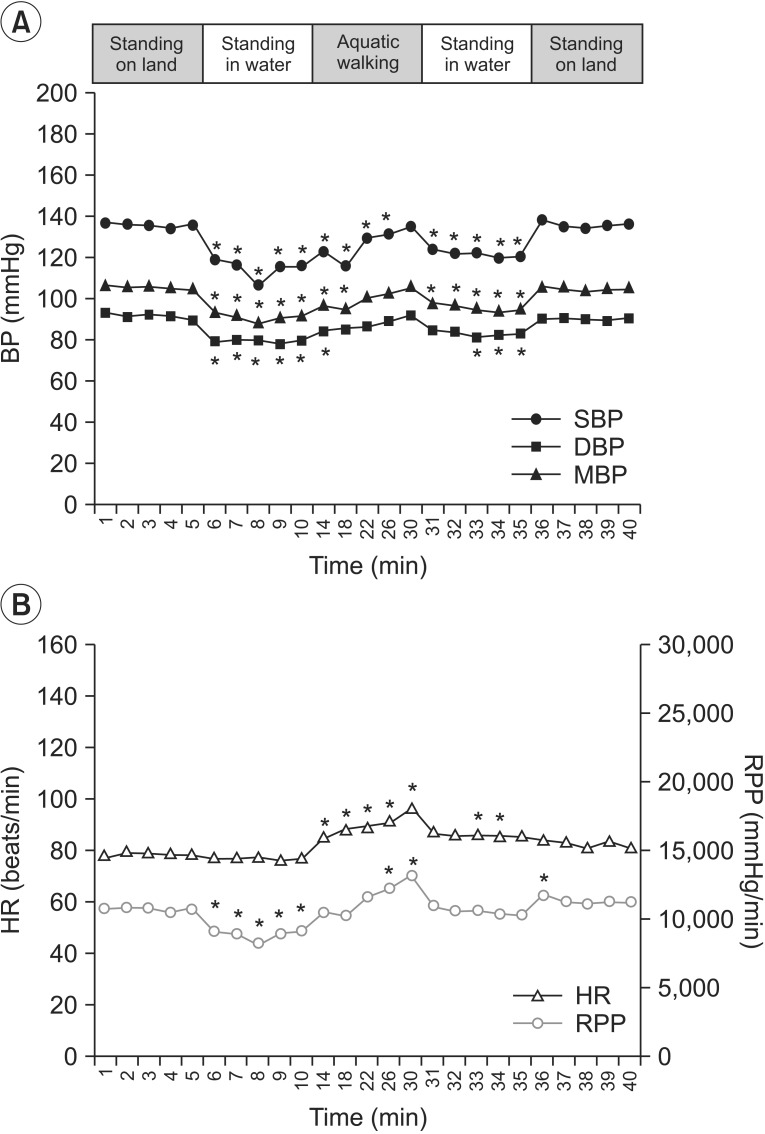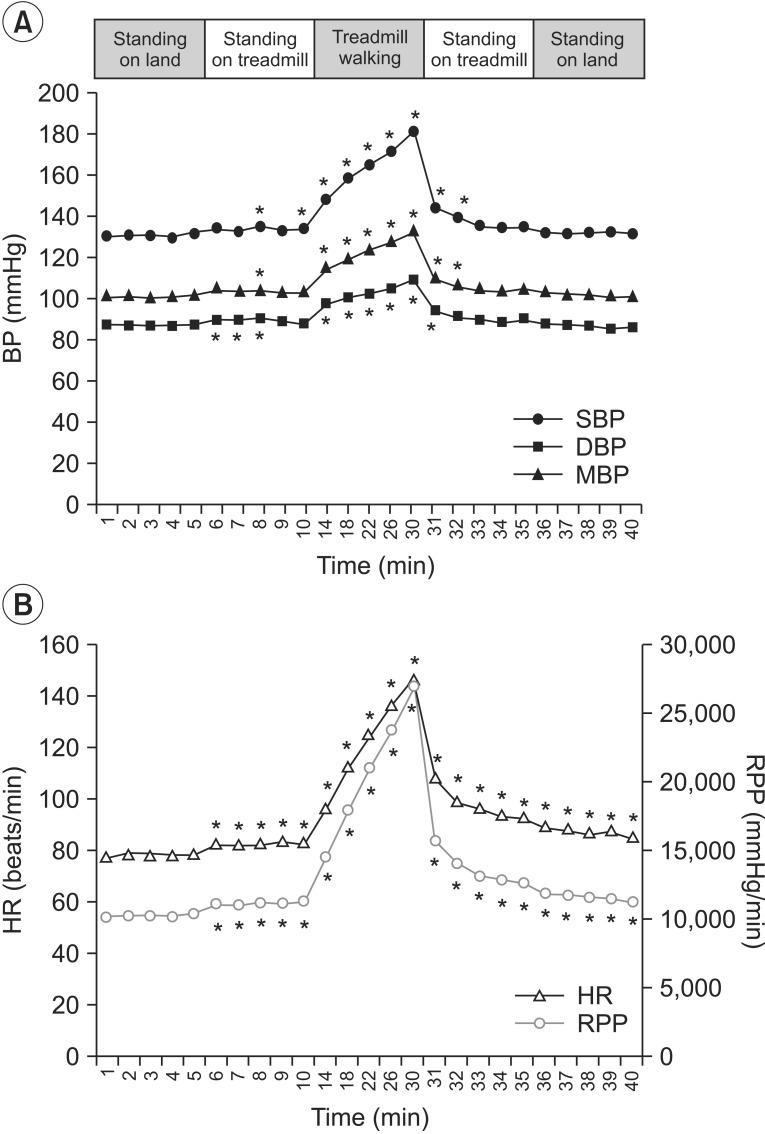Ann Rehabil Med.
2014 Oct;38(5):628-636. 10.5535/arm.2014.38.5.628.
Cardiovascular Response During Submaximal Underwater Treadmill Exercise in Stroke Patients
- Affiliations
-
- 1Department of Physical Medicine and Rehabilitation, Inje University Ilsan Paik Hospital, Goyang, Korea. I9480@paik.ac.kr
- KMID: 2266497
- DOI: http://doi.org/10.5535/arm.2014.38.5.628
Abstract
OBJECTIVE
To evaluate the cardiovascular response during head-out water immersion, underwater treadmill gait, and land treadmill gait in stroke patients.
METHODS
Ten stroke patients were recruited for underwater and land treadmill gait sessions. Each session was 40 minutes long; 5 minutes for standing rest on land, 5 minutes for standing rest in water or on treadmill, 20 minutes for treadmill walking in water or on land, 5 minutes for standing rest in water or on treadmill, and 5 minutes for standing rest on land. Blood pressure (BP) and heart rate (HR) were measured during each session. In order to estimate the cardiovascular workload and myocardial oxygen demand, the rate pressure product (RPP) value was calculated by multiplying systolic BP (SBP) by HR.
RESULTS
SBP, DBP, mean BP (mBP), and RPP decreased significantly after water immersion, but HR was unchanged. During underwater and land treadmill gait, SBP, mBP, DBP, RPP, and HR increased. However, the mean maximum increases in BP, HR and RPP of underwater treadmill walking were significantly lower than that of land treadmill walking.
CONCLUSION
Stroke patients showed different cardiovascular responses during water immersion and underwater gait as opposed to standing and treadmill-walking on land. Water immersion and aquatic treadmill gait may reduce the workload of the cardiovascular system. This study suggested that underwater treadmill may be a safe and useful option for cardiovascular fitness and early ambulation in stroke rehabilitation.
Keyword
MeSH Terms
Figure
Cited by 1 articles
-
Efficacy of Aquatic Treadmill Training on Gait Symmetry and Balance in Subacute Stroke Patients
Mi Eun Lee, Geun Yeol Jo, Hwan Kwon Do, Hee Eun Choi, Woo Jin Kim
Ann Rehabil Med. 2017;41(3):376-386. doi: 10.5535/arm.2017.41.3.376.
Reference
-
1. Grysiewicz RA, Thomas K, Pandey DK. Epidemiology of ischemic and hemorrhagic stroke: incidence, prevalence, mortality, and risk factors. Neurol Clin. 2008; 26:871–895. PMID: 19026895.
Article2. Ada L, Dean CM, Hall JM, Bampton J, Crompton S. A treadmill and overground walking program improves walking in persons residing in the community after stroke: a placebo-controlled, randomized trial. Arch Phys Med Rehabil. 2003; 84:1486–1491. PMID: 14586916.3. Macko RF, Ivey FM, Forrester LW, Hanley D, Sorkin JD, Katzel LI, et al. Treadmill exercise rehabilitation improves ambulatory function and cardiovascular fitness in patients with chronic stroke: a randomized, controlled trial. Stroke. 2005; 36:2206–2211. PMID: 16151035.4. Macko RF, Smith GV, Dobrovolny CL, Sorkin JD, Goldberg AP, Silver KH. Treadmill training improves fitness reserve in chronic stroke patients. Arch Phys Med Rehabil. 2001; 82:879–884. PMID: 11441372.
Article5. Patterson SL, Rodgers MM, Macko RF, Forrester LW. Effect of treadmill exercise training on spatial and temporal gait parameters in subjects with chronic stroke: a preliminary report. J Rehabil Res Dev. 2008; 45:221–228. PMID: 18566940.
Article6. Silver KH, Macko RF, Forrester LW, Goldberg AP, Smith GV. Effects of aerobic treadmill training on gait velocity, cadence, and gait symmetry in chronic hemiparetic stroke: a preliminary report. Neurorehabil Neural Repair. 2000; 14:65–71. PMID: 11228951.
Article7. Bates A, Hanson N. Aquatic exercise therapy. Philadelphia: Saunders;1996.8. Simmons V, Hansen PD. Effectiveness of water exercise on postural mobility in the well elderly: an experimental study on balance enhancement. J Gerontol A Biol Sci Med Sci. 1996; 51:M233–M238. PMID: 8808995.
Article9. Park KS, Choi JK, Park YS. Cardiovascular regulation during water immersion. Appl Human Sci. 1999; 18:233–242.
Article10. Thompson PD, Franklin BA, Balady GJ, Blair SN, Corrado D, Estes NA 3rd, et al. Exercise and acute cardiovascular events placing the risks into perspective: a scientific statement from the American Heart Association Council on Nutrition, Physical Activity, and Metabolism and the Council on Clinical Cardiology. Circulation. 2007; 115:2358–2368. PMID: 17468391.11. Iellamo F. Neural mechanisms of cardiovascular regulation during exercise. Auton Neurosci. 2001; 90:66–75. PMID: 11485294.
Article12. Arborelius M Jr, Ballidin UI, Lilja B, Lundgren CE. Hemodynamic changes in man during immersion with the head above water. Aerosp Med. 1972; 43:592–598. PMID: 5035546.13. Gobel FL, Norstrom LA, Nelson RR, Jorgensen CR, Wang Y. The rate pressure product as an index of myocardial oxygen consumption during exercise in patients with angina pectoris. Circulation. 1978; 57:549–556. PMID: 624164.14. Kelly JO, Kilbreath SL, Davis GM, Zeman B, Raymond J. Cardiorespiratory fitness and walking ability in subacute stroke patients. Arch Phys Med Rehabil. 2003; 84:1780–1785. PMID: 14669183.15. MacKay-Lyons MJ, Howlett J. Exercise capacity and cardiovascular adaptations to aerobic training early after stroke. Top Stroke Rehabil. 2005; 12:31–44. PMID: 15735999.
Article16. Epstein M. Renal effects of head-out water immersion in humans: a 15-year update. Physiol Rev. 1992; 72:563–621. PMID: 1626032.
Article17. Gleim GW, Nicholas JA. Metabolic costs and heart rate responses to treadmill walking in water at different depths and temperatures. Am J Sports Med. 1989; 17:248–252. PMID: 2757128.
Article18. Razminia M, Trivedi A, Molnar J, Elbzour M, Guerrero M, Salem Y, et al. Validation of a new formula for mean arterial pressure calculation: The new formula is superior to the standard formula. Catheter Cardiovasc Interv. 2004; 63:419–425. PMID: 15558774.
Article19. Gabrielsen A, Bie P, Holstein-Rathlou NH, Christensen NJ, Warberg J, Dige-Petersen H, et al. Neuroendocrine and renal effects of intravascular volume expansion in compensated heart failure. Am J Physiol Regul Integr Comp Physiol. 2001; 281:R459–R467. PMID: 11448848.
Article20. Gauer OH. Recent advances in the physiology of whole body immersion. Acta Astronaut. 1975; 2:31–39. PMID: 11841092.
Article21. Asahina M, Asahina MK, Yamanaka Y, Mitsui K, Kitahara A, Murata A. Cardiovascular response during aquatic exercise in patients with osteoarthritis. Am J Phys Med Rehabil. 2010; 89:731–735. PMID: 20729651.
Article22. Kingma B, Frijns A, van Marken Lichtenbelt W. The thermoneutral zone: implications for metabolic studies. Front Biosci (Elite Ed). 2012; 4:1975–1985. PMID: 22202013.
Article23. Mourot L, bouhaddi M, Gandelin E, Cappelle S, Dumoulin G, Wolf JP, et al. Cardiovasuculr autonomic control during short-term thermoneutral and cool head-out immersion. Aviat space Environ Med. 2008; 79:14–20. PMID: 18225773.24. Boussuges A. Immersion in thermoneutral water: effects on arterial compliance. Aviat Space Environ Med. 2006; 77:1183–1187. PMID: 17086775.25. Ivey FM, Gardner AW, Dobrovolny CL, Macko RF. Unilateral impairment of leg blood flow in chronic stroke patients. Cerebrovasc Dis. 2004; 18:283–289. PMID: 15331874.
Article26. Billinger SA, Kluding PM. Use of Doppler ultrasound to assess femoral artery adaptations in the hemiparetic limb in people with stroke. Cerebrovasc Dis. 2009; 27:552–558. PMID: 19390180.
Article27. Landin S, Hagenfeldt L, Saltin B, Wahren J. Muscle metabolism during exercise in hemiparetic patients. Clin Sci Mol Med. 1977; 53:257–269. PMID: 913049.
Article28. Billinger SA, Gajewski BJ, Guo LX, Kluding PM. Single limb exercise induces femoral artery remodeling and improves blood flow in the hemiparetic leg poststroke. Stroke. 2009; 40:3086–3090. PMID: 19520990.
Article29. Wade DT, Wood VA, Heller A, Maggs J, Langton Hewer R. Walking after stroke: measurement and recovery over the first 3 months. Scand J Rehabil Med. 1987; 19:25–30. PMID: 3576138.30. Wall JC, Turnbull GI. Gait asymmetries in residual hemiplegia. Arch Phys Med Rehabil. 1986; 67:550–553. PMID: 3741082.31. Olney SJ, Monga TN, Costigan PA. Mechanical energy of walking of stroke patients. Arch Phys Med Rehabil. 1986; 67:92–98. PMID: 3954572.
Article32. Roth EJ, Merbitz C, Mroczek K, Dugan SA, Suh WW. Hemiplegic gait: relationships between walking speed and other temporal parameters. Am J Phys Med Rehabil. 1997; 76:128–133. PMID: 9129519.33. Kim CM, Eng JJ. Symmetry in vertical ground reaction force is accompanied by symmetry in temporal but not distance variables of gait in persons with stroke. Gait Posture. 2003; 18:23–28. PMID: 12855297.
Article34. von Schroeder HP, Coutts RD, Lyden PD, Billings E Jr, Nickel VL. Gait parameters following stroke: a practical assessment. J Rehabil Res Dev. 1995; 32:25–31. PMID: 7760264.35. Newman AB, Haggerty CL, Kritchevsky SB, Nevitt MC, Simonsick EM. Health ABC Collaborative Research Group. Walking performance and cardiovascular response: associations with age and morbidity: the Health, Aging and Body Composition Study. J Gerontol A Biol Sci Med Sci. 2003; 58:715–720. PMID: 12902529.36. Patterson SL, Forrester LW, Rodgers MM, Ryan AS, Ivey FM, Sorkin JD, et al. Determinants of walking function after stroke: differences by deficit severity. Arch Phys Med Rehabil. 2007; 88:115–119. PMID: 17207686.
Article
- Full Text Links
- Actions
-
Cited
- CITED
-
- Close
- Share
- Similar articles
-
- Evaluation of R Wave Amplitude Changes on Treadmill Exercise Testing
- Usefulness of the Oxygen Uptake Efficiency Slope in the Evaluation of Cardiorespiratory Fitness of the Stroke Patients
- Changes of cardiac output during treadmill exercise by impedance cardiography
- Validity of the Prediction Equation of the Maximal OxygenConsumption in Submaximal Exercise Test
- Treadmill Exercise Improves Motor Function and Short-term Memory by Enhancing Synaptic Plasticity and Neurogenesis in Photothrombotic Stroke Mice



